Did Jesus Exist? - The Historical Argument for Jesus of Nazareth Bart Ehrman (books to read in your 20s txt) 📖

- Author: Bart Ehrman
Book online «Did Jesus Exist? - The Historical Argument for Jesus of Nazareth Bart Ehrman (books to read in your 20s txt) 📖». Author Bart Ehrman
In short, since we know almost nothing about what adherents of the mystery cults believed, we simply cannot assume that they thought of the world like Plutarch and other upper-crust elite philosophers. One thing that we do know about them, however, is where they were located and thus, to some extent, where they exerted significant influence. We know this from the archaeological record they have left behind. Among all our archaeological findings, there is none that suggests that pagan mystery cults exerted any influence on Aramaic-speaking rural Palestinian Judaism in the 20s and 30s of the first century. And this is the milieu out of which faith in Jesus the crucified messiah, as persecuted and then embraced by Paul, emerged.
There are no grounds for assuming that Paul, whose views of Jesus were taken over from the Palestinian Jewish Christians who preceded him, held a radically different view of Jesus from his predecessors. Paul tells us about his background. He was raised a highly religious Jew, and he was a Pharisee. Were Pharisaic Jews influenced by the mystery cults? Did they spend their days plumbing the depths of the myths about Attis and Osiris? Did they look deeply into the mysteries of Isis and Mithras? It is an easy question to answer. These mystery cults are never mentioned by Paul or by any other Christian author of the first hundred years of the church. There is not a stitch of evidence to suggest that mystery cults played any role whatever in the views of the Pharisees or, for that matter, in the views of any Jewish group of the first century: the Sadducees, the Essenes (who produced the Dead Sea Scrolls), the revolutionaries who wanted to overthrow the Romans, the apocalyptic prophets like John the Baptist (and their followers), or the common people. So not only do we not know whether mystery cults were influenced by “the” (alleged) ancient view of the world—whatever that might be—there is not a shred of evidence to suggest that these cults played the least role in the development of early views of Jesus. Rather, we have plenty of reasons, based on our early Jewish sources, that just the opposite was the case.
That in no small part is why not a single early Christian source supports Doherty’s claim that Paul and those before him thought of Jesus as a spiritual, not a human, being who was executed in the spiritual, not the human, sphere. That is not the view of Mark, Matthew, Luke, or John. It is not the view of any of the written sources of any of these Gospels, for example, M and L. It is not the view of any of the oral traditions that later made their way into these Gospels. And it is not the view of the epistles of the New Testament, including Hebrews—the one book of the New Testament that may well reflect some Platonic influence—which unabashedly stresses that Christ “came into the world” (10:5), declares that he made a bloody sacrifice in this world (10:12), and says that “in the days of his flesh he offered up prayers and petitions to the one who was able to save him from death, with strong cries and tears” (5:7). This is not heavenly but earthly suffering. Or consider the book of 1 John, which is quite emphatic not only that Jesus shed his blood (1:7) as an “expiation for sins” (2:2) but also that he was a real, fleshly human being who could be heard, seen, felt, and handled when he was “manifested” here on earth (1:1–3).
So too with Paul. Paul indicates that Jesus was born (in this world) of a woman and as a Jew (Galatians 4:4); he repeatedly stresses that Jesus experienced a real bloody death (for example, Romans 3) and that he was bodily raised from the dead (1 Corinthians 15). This resurrection was not in the heavenly realm for Paul. It was here on earth. That is why Jesus appeared, not to heavenly beings in the upper realm, but to human beings in this one (1 Corinthians 15:5–8). If his resurrection took place here on earth, where was his crucifixion? Paul leaves little doubt about that. Jesus had a last meal with his disciples on the “night” in which he was handed over to his fate. Do they have nights in the spiritual realm? This is a description of something that happened on earth. But even more, Paul stresses that Jesus was buried between his death and his (earthly) resurrection. Surely he means he was buried in a tomb, and that would be here on earth.
The early Christians, Paul included, had a thoroughly apocalyptic understanding of the world, inherited from a Jewish worldview attested long before them, in which this created order would be transformed by the power of God when he brought his kingdom here, to this earth. The kingdom was not an ethereal place in some spiritual realm. For apocalypticists—from the Jewish author of the famous “War Scroll” discovered among the Dead Sea Scrolls to the Christian author of the book of Revelation—the future kingdom would be earthly, through and through (Revelation 20–21). Paul and others expected Jesus to return from heaven, into this very realm where we dwell now (1 Thessalonians 4–5), leading to the transformation of both us and the world (1 Corinthians 15). Paul thought Christ was to “return” here because he had “left” here. This is where he was born, lived, died, and was raised. It all happened here on earth, not in some other celestial realm. Jesus was killed





Comments (0)